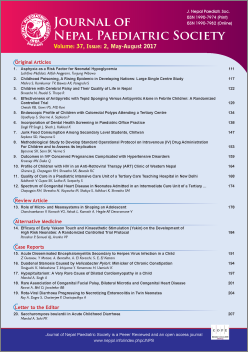Methodological Study to Develop Standard Operational Protocol on Intravenous (IV) Drug Administration For Children and to Assess its Implication
DOI:
https://doi.org/10.3126/jnps.v37i2.17170Keywords:
Intravenous, Nurses, Delphi-technique, CVI, FGDAbstract
Introduction: Medicine administration forms a major part of the registered nurse’s role. Medicines are prescribed by a physician and dispensed by the pharmacist but responsibility for correct administration rests with the registered nurse. Fatal consequences have been noted following wrong drug, dose, diluent and unsterile technique. The objective of this study was to develop standard operational protocol (SOP) on Intravenous (IV) drug administration and checklist to assess the implementations of the developed SOP.
Material and Methods: A methodological research design was adapted to carry out the study. Medicine wards (4-B, 4-C, 5-B and 5-C), Emergency room, PICU at Advanced Paediatric Centre (APC) of Post Graduate Institute of Medical Education and Research (PGIMER), Chandigarh. Thirty observations of IV drug administration and 58 bedside nurses working during July- September 2015. A prospective methodological study was performed to generate SOP. Total 17 FGDs were conducted and data was analysed with SPSS (Version-20.0).
Results: The Content Validity Index (CVI) of SOP and checklist was 99.77% that means all items in both SOP and checklist are valid. Cronbach’s-alpha was calculated to assess Internal Consistency of checklists. Over-all standardized Cronbach’s alpha was calculated 0.94 that means all items in the checklist are internally consistent and contributing to the total reliability of the checklist. All the nurses felt that SOP is useful.
Conclusion: Valid and feasible SOP for drug administration to children through IV route along with valid and reliable checklist was developed. It is recommended to use this document for drug administration for children.
Downloads
Downloads
Additional Files
Published
How to Cite
Issue
Section
License
Authors who publish with this journal agree to the following terms:
Authors retain copyright and grant the journal right of first publication with the work simultaneously licensed under a Creative Commons Attribution License that allows others to share the work with an acknowledgement of the work's authorship and initial publication in this journal.
Authors are able to enter into separate, additional contractual arrangements for the non-exclusive distribution of the journal's published version of the work (e.g., post it to an institutional repository or publish it in a book), with an acknowledgement of its initial publication in this journal.
Authors are permitted and encouraged to post their work online (e.g., in institutional repositories or on their website) prior to and during the submission process, as it can lead to productive exchanges, as well as earlier and greater citation of published work (See The Effect of Open Access).



